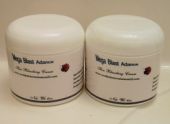 In many parts of Asia, South America and Africa, skin whitening has become big business. The popularity of these products has risen steadily over the years and demand has surged so quickly for a better cream, ointment, soap, lotion or even pill that many manufacturers have resorted to using highly toxic materials as skin whitening ingredients and utilizing unsafe production practices.
In many parts of Asia, South America and Africa, skin whitening has become big business. The popularity of these products has risen steadily over the years and demand has surged so quickly for a better cream, ointment, soap, lotion or even pill that many manufacturers have resorted to using highly toxic materials as skin whitening ingredients and utilizing unsafe production practices.
Suffice it to say that out of a dozen skin whitening products available over-the-counter today, at least half are suspect. There are actually brands with active ingredients that can cause a variety of unpleasant side effects, ranging from scarring to kidney problems to cancer. In spite of restrictions and even outright banning, these skin whitening ingredients are still in use in a good number of products. Here are three of the most commonly used and their side effects:
Hydroquinone
Hydroquinone was once the standard upon which most skin whitening products were based upon. As the active ingredient in toners and astringents, hydroquinone promised an easy and pain-free treatment for common problems with skin hyperpigmentation by inhibiting the production of melanin. Melanin is the pigment that occurs naturally in human skin, producing its color. By preventing the skin’s ability to produce melanin naturally, hydroquinone helps lighten skin color.
Hydroquinone was the main ingredient in many skin lightening products that appeared in the U.S. market, becoming more popular thanks to its approval as an over-the-counter treatment by the FDA.
Unfortunately, hydroquinone is not as safe as it was purported to be. There have been studies that linked the ingredient to a variety of health issues, including increased risks of developing cancer and causing problems in the adrenal gland. Some studies have also linked hydroquinone to ochronosis, a disorder that, ironically, results to darker, grayish-black skin pigmentation.
Today, over-the-counter skin whitening products containing hydroquinone are banned in Japan, Australia and in Europe. It is still available as an ingredient for certain skin treatments but it is recommended with a dermatologist’s prescription to ensure proper dosage and use.
Mercury
Mercury, a toxic heavy metal, can also be found as an active ingredient in numerous skin whitening products, usually in the form of mercury chloride. As a reagent, it is highly soluble in water, making it easier to mix in a solution.
Even if used in small dosages, mercury chloride can pose a significant threat to health. Mercury is a known cause of kidney and neurological damage, as shown in laboratory tests in rats and in studies involving humans. Over the long term, the adverse effects of mercury to the kidneys, nerves and the brain are also irreversible.
Mercury chloride, incidentally, is also an ingredient used in the manufacture of fungicides, insecticides, wood preservatives and for the preservation of biological and anthropological specimens. Before the discovery of antibiotics, mercury chloride was used for the treatment of syphilis.
Today, the FDA bans over-the-counter skin whitening products that use even the smallest concentration of mercury.
Glucocorticosteroids
Corticosteriods are hormones produced naturally by the body’s adrenal glands. These hormones control the body’s immune responses, regulate carbohydrate metabolism and help decrease inflammation. Glucocorticosteroids are a type of corticosteroid. They are being manufactured synthetically for use in the treatment of a variety of conditions and skin problems, including asthma, arthritis, dermatitis, psoriasis and eczema. They are also used as the active ingredient in skin whitening products.
Glucocorticosteroids are popular in certain countries as ointments and creams. They are applied to lighten common skin hyperpigmentations such as age spots and scars. Glucocorticosteroids are considered safe but only up to a certain dosage and length of use. As a treatment, for example, it is only recommended for continuous application for up to 15 days, after which application should be stopped.
Prolonged use of a skin whitening product containing glucocorticosteroids as an active ingredient raises the risk of developing adverse side effects such as inflammation, acne, osteoporosis, cataracts and muscle weakness.
The use of these ingredients for skin care is being monitored and regulated by the FDA. Such regulations or restrictions may not always be implemented in other countries, which make it important that buying customers equip themselves with the right information not just regarding the product’s efficacy but also its safety.















